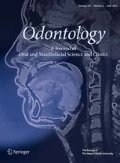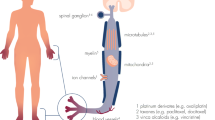Abstract
Root development of permanent teeth is disturbed in survivors of childhood cancer. Cyclophosphamide (CY) is a cytostatic drug commonly used for chemotherapy in children with cancer. This study aimed to evaluate the effects of CY on the development of molar teeth until the completion of occlusion in young mice, focusing on Hertwig’s epithelial root sheath (HERS). We treated thirty-two 12-day-old ICR mice with CY (100 mg/kg; 100-CY group), and 36 control mice with saline. At 12, 14, 16, 20, 24, 27, 39, 60, and 76 days of age, the mandibular molars were removed. Soft X-ray radiographs were obtained in lateral projection. The root/crown length (R/C) ratio of the first molar was calculated. Serial sagittal sections were prepared and histomorphological hematoxylin and eosin (HE) staining and immunohistochemical (cytokeratin) studies were performed. The R/C ratio of the 100-CY group (0.78) was smaller than that of the control group (1.23) at 76 days (p < 0.05, t test). While all roots developed further after injection, microscopic examination showed that the roots of the first molars that developed in the 100-CY group were shorter than those in the control group. In addition, experimental mice showed apical closure of the roots. By 20 days after injection, the HERS had disappeared from the root surface in the 100-CY group. In conclusion, this study indicates that CY can induce a defect in HERS and cause early loss of HERS. Disruption of the epithelial sheath inhibits normal root formation, and it could cause irreversible short-root development.







Similar content being viewed by others
References
Gatta G, Capocaccia R, Coleman MP, Ries LA, Berrino F. Childhood cancer survival in Europe and the United States. Cancer. 2002;95:1767–72.
Maeda M. Late effects of childhood cancer: life-threatening issues. J Nippon Med Sch. 2008;75:320–4.
Ishida Y, Honda M, Ozono S, Okamura J, Asami K, Maeda N, Sakamoto N, Inada H, Iwai T, Kamibeppu K, Kakee N, Horibe K. Late effects and quality of life of childhood cancer survivors: part 1. Impact of stem cell transplantation. Int J Hematol. 2010;91:865–76.
Ishida Y, Sakamoto N, Kamibeppu K, Kakee N, Iwai T, Ozono S, Maeda N, Okamura J, Asami K, Inada H, Honda M, Horibe K. Late effects and quality of life of childhood cancer survivors: part 2. Impact of radiotherapy. Int J Hematol. 2010;92:95–104.
Dahllöf G, Wondimu B, Barr-Agholme M, Garming-Legert K, Remberger M, Ringden O. Xerostomia in children and adolescents after stem cell transplantation conditioned with total body irradiation or busulfan. Oral Oncol. 2011;47:915–9.
Javed F, Utreja A, Bello Correa FO, Al-Askar M, Hudieb M, Qayyum F, Al-Rasheed A, Almas K, Al-Hezaimi K. Oral health status in children with acute lymphoblastic leukemia. Crit Rev Oncol Hematol. 2012;83:303–9.
Minicucci EM, Lopes LF, Crocci AJ. Dental abnormalities in children after chemotherapy treatment for acute lymphoid leukemia. Leuk Res. 2003;27:45–50.
Vesterbacka M, Ringden O, Remberger M, Huggare J, Dahllof G. Disturbances in dental development and craniofacial growth in children treated with hematopoietic stem cell transplantation. Orthod Craniofac Res. 2012;15:21–9.
Cubukcu CE, Sevinir B, Ercan I. Disturbed dental development of permanent teeth in children with solid tumors and lymphomas. Pediatr Blood Cancer. 2012;58:80–4.
Remmers D, Bokkerink JP, Katsaros C. Microdontia after chemotherapy in a child treated for neuroblastoma. Orthod Craniofac Res. 2006;9:206–10.
Koppang HS. Histomorphologic investigations on the effect of cyclophosphamide on dentinogenesis of the rat incisor. Scand J Dent Res. 1973;81:383–96.
Dahl JE. Immediate and delayed effects of repeated doxorubicin injections on rat incisor mesenchymal cells. Acta Odontol Scand. 1985;43:155–62.
de Jonge ME, Huitema AD, Rodenhuis S, Beijnen JH. Clinical pharmacokinetics of cyclophosphamide. Clin Pharmacokinet. 2005;44:1135–64.
Näsman M, Hammarström L. Influence of the antineoplastic agent cyclophosphamide on dental development in rat molars. Acta Odontol Scand. 1996;54:287–94.
Näsman M, Hultenby K, Forsberg CM. A scanning electron microscopy study of disturbances in the developing rat molar induced by cyclophosphamide. Acta Odontol Scand. 1997;55:186–91.
Lind V. Short root anomaly. Scand J Dent Res. 1972;80:85–93.
Pedersen LB, Clausen N, Schroder H, Schmidt M, Poulsen S. Microdontia and hypodontia of premolars and permanent molars in childhood cancer survivors after chemotherapy. Int J Paediatr Dent. 2012;22:239–43.
Hsieh SG, Hibbert S, Shaw P, Ahern V, Arora M. Association of cyclophosphamide use with dental developmental defects and salivary gland dysfunction in recipients of childhood antineoplastic therapy. Cancer. 2011;117:2219–27.
Höltta P, Hovi L, Saarinen-Pihkala UM, Peltola J, Alaluusua S. Disturbed root development of permanent teeth after pediatric stem cell transplantation. Dental root development after SCT. Cancer. 2005;103:1484–93.
Ishida Y, Maeda M, Urayama KY, Kiyotani C, Aoki Y, Kato Y, Goto S, Sakaguchi S, Sugita K, Tokuyama M, Nakadate N, Ishii E, Tsuchida M, Ohara A, The QOLcoTCsCSG. Secondary cancers among children with acute lymphoblastic leukaemia treated by the Tokyo Children’s Cancer Study Group protocols: a retrospective cohort study. Br J Haematol. 2014;164:101–12.
Adatia AK. The effects of cyclophosphamide on odontogenesis in the rat. Arch Oral Biol. 1975;20:141–4.
Adatia AK. Cytotoxicity of cyclophosphamide in the rat incisor. Br J Cancer. 1975;32:208–18.
Ten Cate AR. The role of epithelium in the development, structure and function of the tissues of tooth support. Oral Dis. 1996;2:55–62.
Madan AK, Kramer B. Immunolocalization of fibroblast growth factor-2 (FGF-2) in the developing root and supporting structures of the murine tooth. J Mol Histol. 2005;36:171–8.
Nakatomi M, Morita I, Eto K, Ota MS. Sonic hedgehog signaling is important in tooth root development. J Dent Res. 2006;85:427–31.
Fujiwara N, Tabata MJ, Endoh M, Ishizeki K, Nawa T. Insulin-like growth factor-I stimulates cell proliferation in the outer layer of Hertwig’s epithelial root sheath and elongation of the tooth root in mouse molars in vitro. Cell Tissue Res. 2005;320:69–75.
Anton E. Ultrastructural study of the effect of cyclophosphamide on the growth area of incisor teeth of DBA/2 and C57BL/6 mice. Int J Exp Pathol. 1996;77:83–8.
Thomas HF. Root formation. Int J Dev Biol. 1995;39:231–7.
Diekwisch TG. The developmental biology of cementum. Int J Dev Biol. 2001;45:695–706.
Näsman M, Forsberg CM, Dahllöf G. Long-term dental development in children after treatment for malignant disease. Eur J Orthod. 1997;19:151–9.
Avsar A, Elli M, Darka O, Pinarli G. Long-term effects of chemotherapy on caries formation, dental development, and salivary factors in childhood cancer survivors. Oral Surg Oral Med Oral Pathol Oral Radiol Endod. 2007;104:781–9.
Kaste SC, Goodman P, Leisenring W, Stovall M, Hayashi RJ, Yeazel M, Beiraghi S, Hudson MM, Sklar CA, Robison LL, Baker KS. Impact of radiation and chemotherapy on risk of dental abnormalities: a report from the Childhood Cancer Survivor Study. Cancer. 2009;115:5817–27.
Acknowledgments
This work was supported by Grants-in-Aid for Scientific Research (C) 20592416 and (C) 23593048 from the Japan Society for the Promotion of Science, Tokyo, Japan.
Conflict of interest
The authors report no conflicts of interest related to this study.
Author information
Authors and Affiliations
Corresponding author
Rights and permissions
About this article
Cite this article
Kawakami, T., Nakamura, Y. & Karibe, H. Cyclophosphamide inhibits root development of molar teeth in growing mice. Odontology 103, 143–151 (2015). https://doi.org/10.1007/s10266-014-0158-1
Received:
Accepted:
Published:
Issue Date:
DOI: https://doi.org/10.1007/s10266-014-0158-1




